| Common name | Scientific name and subspecies | Range | Size and ecology | IUCN status and estimated population |
|---|
| Aba roundleaf bat
| H. abae
Allen, 1917 | Central and western Africa
 | Size: 6–7 cm (2–3 in) long, plus 2–4 cm (1–2 in) tail
5–7 cm (2–3 in) forearm length [19]
Habitat: Savanna and rocky areas [20] | LC
Unknown  [20] [20]
|
|---|
| Aellen's roundleaf bat
| H. marisae
Aellen, 1954 | Western Africa
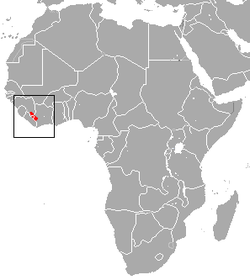 | Size: 4–5 cm (2 in) long, plus 1–3 cm (0.4–1.2 in) tail
3–5 cm (1–2 in) forearm length [19]
Habitat: Caves, rocky areas, and forest [21] | VU
Unknown  [21] [21]
|
|---|
| Andersen's leaf-nosed bat
| H. gentilis
Andersen, 1918 | Southern and southeastern Asia | Size: About 4 cm (2 in) long, plus 2–4 cm (1–2 in) tail
3–5 cm (1–2 in) forearm length [19]
Habitat: Forest and caves [22] | LC
Unknown  [22] [22]
|
|---|
| Arnhem leaf-nosed bat
| H. inornatus
McKean, 1970 | Northern Australia
 | Size: 6–8 cm (2–3 in) long, plus 3–5 cm (1–2 in) tail
6–8 cm (2–3 in) forearm length [19]
Habitat: Forest, savanna, shrubland, and caves [23] | VU
Unknown  [23] [23]
|
|---|
| Ashy roundleaf bat  | H. cineraceus
Blyth, 1853
- H. c. cineraceus
- H. c. wrighti
| Southern and southeastern Asia
 | Size: Unknown length
3–4 cm (1–2 in) forearm length [19]
Habitat: Forest and caves [24] | LC
Unknown  [24] [24]
|
|---|
| Benito roundleaf bat  | H. beatus
K. Andersen, 1906
- H. b. beatus
- H. b. maximus
| Central and western Africa
 | Size: 4–5 cm (2 in) long, plus 2–4 cm (1–2 in) tail
3–5 cm (1–2 in) forearm length [19]
Habitat: Forest and inland wetlands [25] | LC
Unknown  [25] [25]
|
|---|
| Biak roundleaf bat  | H. papua
(Thomas & Doria, 1886) | Indonesia
 | Size: 4–6 cm (2 in) long, plus 2–4 cm (1–2 in) tail
4–6 cm (2 in) forearm length [19]
Habitat: Forest and caves [26] | LC
Unknown  [26] [26]
|
|---|
| Bicolored roundleaf bat  | H. bicolor
(Temminck, 1834) | Southeastern Asia
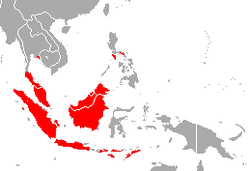 | Size: Unknown length
4–5 cm (2 in) forearm length [19]
Habitat: Forest and caves [27] | LC
Unknown  [27] [27]
|
|---|
| Big-eared roundleaf bat  | H. macrobullatus
Tate, 1941 | Indonesia
 | Size: Unknown length
4–5 cm (2 in) forearm length [19]
Habitat: Forest and caves [28] | DD
Unknown  [28] [28]
|
|---|
| Boeadi's roundleaf bat
| H. boeadii
Rossiter, Suyanto, Kingston, & Bates, 2007 | Indonesia | Size: Unknown length, plus 1–2 cm (0.4–0.8 in) tail
4–5 cm (2 in) forearm length [19]
Habitat: Forest [29] | DD
Unknown  [29] [29]
|
|---|
| Borneo roundleaf bat
| H. doriae
(Peters, 1871) | Southeastern Asia
 | Size: Unknown length
3–4 cm (1–2 in) forearm length [19]
Habitat: Forest [30] | NT
Unknown  [30] [30]
|
|---|
| Cantor's roundleaf bat  | H. galeritus
Cantor, 1846 | Southern and southeastern Asia
 | Size: 4–6 cm (2 in) long, plus 2–4 cm (1–2 in) tail
4–6 cm (2 in) forearm length [19]
Habitat: Rocky areas, caves, and forest [31] | LC
Unknown  [31] [31]
|
|---|
| Cox's roundleaf bat
| H. coxi
Shelford, 1901 | Western Borneo
 | Size: Unknown length
5–6 cm (2 in) forearm length [19]
Habitat: Unknown [32] | EN
Unknown  [32] [32]
|
|---|
| Crested roundleaf bat
| H. inexpectatus
Laurie & Hill, 1954 | Indonesia
 | Size: Unknown length
About 10 cm (4 in) forearm length [19]
Habitat: Caves and unknown [33] | DD
Unknown  [33] [33]
|
|---|
| Dayak roundleaf bat  | H. dyacorum
Thomas, 1902 | Indonesia and Malaysia
 | Size: Unknown length
3–5 cm (1–2 in) forearm length [19]
Habitat: Forest and caves [34] | LC
Unknown  [34] [34]
|
|---|
| Diadem leaf-nosed bat  | H. diadema
(É. Geoffroy, 1813) | Southeastern Asia
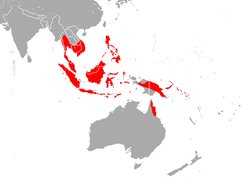 | Size: 6–10 cm (2–4 in) long, plus 3–6 cm (1–2 in) tail
5–10 cm (2–4 in) forearm length [19]
Habitat: Forest, savanna, and caves [35] | LC
Unknown  [35] [35]
|
|---|
| Dusky leaf-nosed bat  | H. ater
Templeton, 1848
- H. a. amboinensis
- H. a. aruensis
- H. a. ater
- H. a. gilberti
- H. a. nicobarulae
- H. a. saevus
|
 | Size: 3–5 cm (1–2 in) long, plus 1–3 cm (0.4–1.2 in) tail
1–5 cm (0.4–2.0 in) forearm length [19]
Habitat: Forest, savanna, shrubland, and caves [36] | LC
Unknown  [36] [36]
|
|---|
| Ethiopian large-eared roundleaf bat
| H. megalotis
(Heuglin, 1862) | Eastern Africa
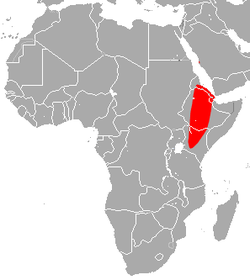 | Size: About 4 cm (2 in) long, plus 2–3 cm (1 in) tail
3–4 cm (1–2 in) forearm length [19]
Habitat: Savanna and shrubland [37] | LC
Unknown  [37] [37]
|
|---|
| Fawn leaf-nosed bat  | H. cervinus
(Gould, 1854)
- H. c. batchianus
- H. c. cervinus
- H. c. labuanensis
- H. c. misoriensis
| Southeastern Asia
 | Size: 5–6 cm (2 in) long, plus 2–4 cm (1–2 in) tail
4–6 cm (2 in) forearm length [19]
Habitat: Forest and caves [38] | LC
Unknown  [38] [38]
|
|---|
| Fierce roundleaf bat
| H. dinops
K. Andersen, 1905 | Northeastern Oceania
 | Size: 8–11 cm (3–4 in) long, plus 5–7 cm (2–3 in) tail
8–10 cm (3–4 in) forearm length [19]
Habitat: Forest and caves [39] | VU
6,000  [39] [39]
|
|---|
| Fly River roundleaf bat  | H. muscinus
(Thomas & Doria, 1886) | New Guinea
 | Size: 4–6 cm (2 in) long, plus about 2 cm (1 in) tail
4–5 cm (2 in) forearm length [5]
Habitat: Forest [40] | LC
Unknown  [40] [40]
|
|---|
| Fulvus roundleaf bat  | H. fulvus
Gray, 1838 | Southern Asia
 | Size: 4–5 cm (2 in) long, plus 2–4 cm (1–2 in) tail
3–5 cm (1–2 in) forearm length [19]
Habitat: Forest and caves [41] | LC
Unknown  [41] [41]
|
|---|
| Grand roundleaf bat
| H. grandis
Allen, 1936 | Southeastern Asia
 | Size: 6–8 cm (2–3 in) long, plus 3–5 cm (1–2 in) tail
5–7 cm (2–3 in) forearm length [19]
Habitat: Caves and unknown [42] | LC
Unknown  [42] [42]
|
|---|
| Great roundleaf bat  | H. armiger
(Hodgson, 1835)
- H. a. armiger
- H. a. fujianensis
- H. a. terasensis
- H. a. tranninhensis
| Eastern and southeastern Asia
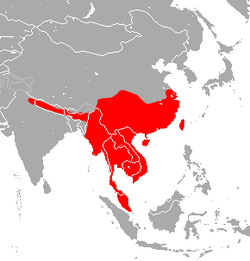 | Size: 8–11 cm (3–4 in) long, plus 4–7 cm (2–3 in) tail
8–11 cm (3–4 in) forearm length [19]
Habitat: Forest and caves [43] | LC
Unknown  [43] [43]
|
|---|
| Griffin's leaf-nosed bat
| H. griffini
Thong et al., 2012 | Vietnam | Size: Unknown length
8–9 cm (3–4 in) forearm length [19]
Habitat: Forest and caves [44] | NT
Unknown  [44] [44]
|
|---|
| Ha Long leaf-nosed bat
| H. alongensis
Bourret, 1942 | Vietnam | Size: Unknown length
6–8 cm (2–3 in) forearm length [19]
Habitat: Forest and caves [45] | VU
9,000  [45] [45]
|
|---|
| Hill's roundleaf bat
| H. edwardshilli
Flannery & Colgan, 1993 | Northern Papua New Guinea
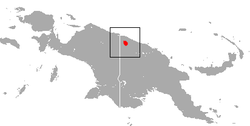 | Size: About 5 cm (2 in) long, plus 1–2 cm (0.4–0.8 in) tail
4–6 cm (2 in) forearm length [5]
Habitat: Forest and caves [46] | VU
Unknown  [46] [46]
|
|---|
| House-dwelling leaf-nosed bat
| H. einnaythu
Douangboubpha et al., 2011 | Myanmar | Size: Unknown length
3–4 cm (1–2 in) forearm length [19]
Habitat: Unknown [47] | DD
Unknown  [47] [47]
|
|---|
| Indian roundleaf bat  | H. lankadiva
Kelaart, 1850 | Southern Asia
 | Size: Unknown length, plus 3–6 cm (1–2 in) tail
7–10 cm (3–4 in) forearm length [19]
Habitat: Forest, shrubland, and caves [48] | LC
Unknown  [48] [48]
|
|---|
| Intermediate roundleaf bat  | H. larvatus
(Horsfield, 1823) | Southeastern Asia
 | Size: 5–8 cm (2–3 in) long, plus 3–4 cm (1–2 in) tail
5–7 cm (2–3 in) forearm length [19]
Habitat: Forest and caves [49] | LC
Unknown  [49] [49]
|
|---|
| Jones's roundleaf bat
| H. jonesi
Hayman, 1947 | Western Africa
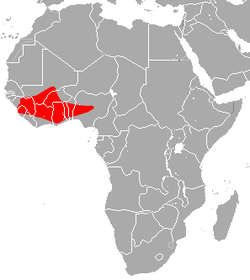 | Size: 5–6 cm (2 in) long, plus 1–3 cm (0.4–1.2 in) tail
4–5 cm (2 in) forearm length [19]
Habitat: Forest, savanna, grassland, rocky areas, and caves [50] | NT
Unknown  [50] [50]
|
|---|
| Khajuria's leaf-nosed bat  | H. durgadasi
Khajuria, 1970 | Central India
 | Size: 3–5 cm (1–2 in) long, plus 2–3 cm (1 in) tail
3–4 cm (1–2 in) forearm length [19]
Habitat: Forest and caves [51] | VU
Unknown  [51] [51]
|
|---|
| Kolar leaf-nosed bat  | H. hypophyllus
Kock & Bhat, 1994 | Southern India
 | Size: 4–5 cm (2 in) long, plus 2–3 cm (1 in) tail
3–5 cm (1–2 in) forearm length [19]
Habitat: Shrubland and caves [52] | CR
150–200  [52] [52]
|
|---|
| Lamotte's roundleaf bat
| H. lamottei
(Brosset, 1984) | Western Africa
 | Size: 9–11 cm (4 in) long, plus 3–5 cm (1–2 in) tail
5–6 cm (2 in) forearm length [19]
Habitat: Forest, grassland, and caves [53] | CR
Unknown  [53] [53]
|
|---|
| Laotian leaf-nosed bat
| H. rotalis
Francis, Kock, & Habersetzer, 1999 | Laos | Size: Unknown length, plus 3–4 cm (1–2 in) tail
4–5 cm (2 in) forearm length [19]
Habitat: Forest [54] | LC
Unknown  [54] [54]
|
|---|
| Large Asian roundleaf bat
| H. lekaguli
Thonglongya & Hill, 1974 | Southeastern Asia
 | Size: Unknown length
6–8 cm (2–3 in) forearm length [19]
Habitat: Forest and caves [55] | NT
Unknown  [55] [55]
|
|---|
| Large Mindanao roundleaf bat
| H. coronatus
Peters, 1871 | Philippines
 | Size: 8–9 cm (3–4 in) long, plus 2–3 cm (1 in) tail
About 5 cm (2 in) forearm length [19]
Habitat: Forest and caves [56] | DD
Unknown  [56] [56]
|
|---|
| Lesser great leaf-nosed bat 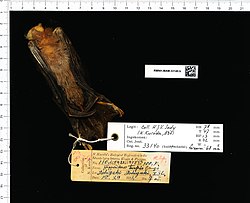 | H. turpis
Bangs, 1901 | Japan | Size: 6–9 cm (2–4 in) long, plus 4–6 cm (2 in) tail
6–8 cm (2–3 in) forearm length [19]
Habitat: Forest, inland wetlands, and caves [57] | EN
Unknown  [57] [57]
|
|---|
| Maduran leaf-nosed bat
| H. madurae
Kitchener & Maryanto, 1993 | Indonesia
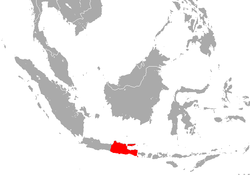 | Size: Unknown length, plus 2–4 cm (1–2 in) tail
5–6 cm (2 in) forearm length [19]
Habitat: Forest and caves [58] | NT
Unknown  [58] [58]
|
|---|
| Maggie Taylor's roundleaf bat
| H. maggietaylorae
Smith & Hill, 1981
- H. m. erroris
- H. m. maggietaylorae
| New Guinea and nearby islands
 | Size: 5–8 cm (2–3 in) long, plus 3–5 cm (1–2 in) tail
5–7 cm (2–3 in) forearm length [19]
Habitat: Caves, shrubland, and forest [59] | LC
Unknown  [59] [59]
|
|---|
| Maghreb Leaf-nosed Bat
| H. tephrus
Cabrera, 1906 | Morocco, Yemen, and Senegal | Size: 4–5 cm (2 in) long, plus 2–4 cm (1–2 in) tail
Unknown forearm length [19]
Habitat: Forest and savanna [60] | LC
Unknown  [60] [60]
|
|---|
| Makira roundleaf bat
| H. demissus
K. Andersen, 1909 | Solomon Islands
 | Size: 6–7 cm (2–3 in) long, plus 3–5 cm (1–2 in) tail
About 7 cm (3 in) forearm length [19]
Habitat: Forest and caves [61] | EN
Unknown  [61] [61]
|
|---|
| Malayan roundleaf bat
| H. nequam
K. Andersen, 1918 | Malaysia
 | Size: Unknown length
About 5 cm (2 in) forearm length [19]
Habitat: Unknown [62] | DD
Unknown  [62] [62]
|
|---|
| Nicobar leaf-nosed bat
| H. nicobarulae
Miller, 1902 | Nicobar Islands | Size: Unknown length
3–5 cm (1–2 in) forearm length [19]
Habitat: Forest and caves [63] | EN
Unknown  [63] [63]
|
|---|
| Noack's roundleaf bat  | H. ruber
Noack, 1893
- H. r. guineensis
- H. r. ruber
| Sub-Saharan Africa
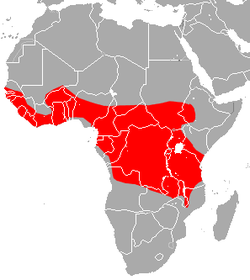 | Size: 5–7 cm (2–3 in) long, plus 3–5 cm (1–2 in) tail
4–6 cm (2 in) forearm length [19]
Habitat: Forest, savanna, and caves [64] | LC
Unknown  [64] [64]
|
|---|
| Northern leaf-nosed bat
| H. stenotis
Thomas, 1913 | Northern Australia
 | Size: 4–5 cm (2 in) long, plus 2–3 cm (1 in) tail
4–5 cm (2 in) forearm length [5]
Habitat: Savanna, rocky areas, and caves [65] | VU
5,000  [65] [65]
|
|---|
| Orbiculus leaf-nosed bat
| H. orbiculus
Francis, Kock, & Habersetzer, 1999 | Sumatra island in Indonesia and Malaysia
 | Size: Unknown length, plus 2–4 cm (1–2 in) tail
4–5 cm (2 in) forearm length [19]
Habitat: Forest [66] | VU
Unknown  [66] [66]
|
|---|
| Peleng leaf-nosed bat
| H. pelingensis
Shamel, 1940 | Sulawesi island in Indonesia
 | Size: Unknown length
9–10 cm (4 in) forearm length [19]
Habitat: Forest and caves [67] | NT
Unknown  [67] [67]
|
|---|
| Pendlebury's roundleaf bat  | H. pendleburyi
Chasen, 1936 | Thailand
 | Size: Unknown length, plus 4–7 cm (2–3 in) tail
7–9 cm (3–4 in) forearm length [19]
Habitat: Forest and caves [68] | VU
4,700  [68] [68]
|
|---|
| Philippine forest roundleaf bat
| H. obscurus
(Peters, 1861) | Philippines
 | Size: 5–6 cm (2 in) long, plus 1–3 cm (0.4–1.2 in) tail
4–5 cm (2 in) forearm length [19]
Habitat: Forest and caves [69] | LC
Unknown  [69] [69]
|
|---|
| Philippine pygmy roundleaf bat
| H. pygmaeus
(Waterhouse, 1843) | Philippines
 | Size: 5–8 cm (2–3 in) long, plus 1–3 cm (0.4–1.2 in) tail
3–5 cm (1–2 in) forearm length [19]
Habitat: Forest and caves [70] | LC
Unknown  [70] [70]
|
|---|
| Phou Khao Khouay leaf-nosed bat  | H. khaokhouayensis
Guillén-Servent & Francis, 2009 | Laos and Vietnam
 | Size: Unknown length
4–5 cm (2 in) forearm length [19]
Habitat: Forest [71] | VU
8,000–10,000  [71] [71]
|
|---|
| Pomona roundleaf bat  | H. pomona
K. Andersen, 1918 | India | Size: Unknown length
3–4 cm (1–2 in) forearm length [19]
Habitat: Forest and caves [72] | EN
Unknown  [72] [72]
|
|---|
| Pratt's roundleaf bat  | H. pratti
Thomas, 1891 | Eastern Asia
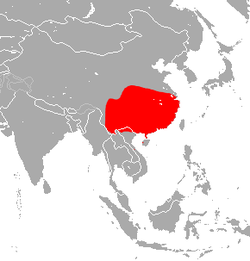 | Size: 9–11 cm (4 in) long, plus 5–7 cm (2–3 in) tail
7–9 cm (3–4 in) forearm length [19]
Habitat: Caves [73] | LC
Unknown  [73] [73]
|
|---|
| Ridley's leaf-nosed bat 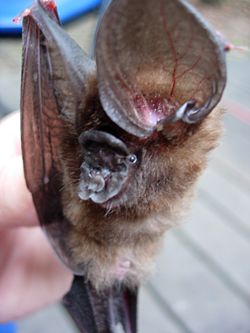 | H. ridleyi
Robinson & Kloss, 1911 | Southeastern Asia
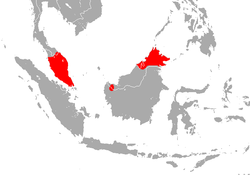 | Size: Unknown length, plus 2–3 cm (1 in) tail
4–6 cm (2 in) forearm length [19]
Habitat: Forest [74] | VU
Unknown  [74] [74]
|
|---|
| Schneider's leaf-nosed bat  | H. speoris
(Schneider, 1800) | India
 | Size: 4–7 cm (2–3 in) long
4–6 cm (2 in) forearm length [19]
Habitat: Forest, shrubland, rocky areas, and caves [75] | LC
Unknown  [75] [75]
|
|---|
| Semon's leaf-nosed bat
| H. semoni
Matschie, 1903 | Northeastern Australia
 | Size: 4–5 cm (2 in) long, plus 2–3 cm (1 in) tail
3–5 cm (1–2 in) forearm length [5]
Habitat: Forest, savanna, and caves [76] | LC
Unknown  [76] [76]
|
|---|
| Shield-faced roundleaf bat  | H. lylei
Thomas, 1913 | Southeastern Asia
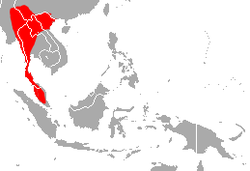 | Size: 7–10 cm (3–4 in) long, plus 4–6 cm (2 in) tail
7–9 cm (3–4 in) forearm length [19]
Habitat: Forest and caves [77] | LC
Unknown  [77] [77]
|
|---|
| Shield-nosed leaf-nosed bat
| H. scutinares
Robinson, Jenkins, Francis, & Fulford, 2003 | Laos and Vietnam
 | Size: Unknown length, plus 5–6 cm (2 in) tail
7–9 cm (3–4 in) forearm length [19]
Habitat: Forest and caves [78] | VU
8,000–10,000  [78] [78]
|
|---|
| Short-headed roundleaf bat
| H. breviceps
Tate, 1941 | Indonesia
 | Size: About 4 cm (2 in) long, plus about 2 cm (1 in) tail
About 4 cm (2 in) forearm length [19]
Habitat: Forest and caves [79] | DD
Unknown  [79] [79]
|
|---|
| Short-tailed roundleaf bat
| H. curtus
Allen, 1921 | Cameroon and Equatorial Guinea
 | Size: 5–6 cm (2 in) long, plus 1–3 cm (0.4–1.2 in) tail
4–5 cm (2 in) forearm length [19]
Habitat: Forest and caves [80] | EN
Unknown  [80] [80]
|
|---|
| Sooty roundleaf bat  | H. fuliginosus
(Temminck, 1853) | Central and western Africa
 | Size: 8–10 cm (3–4 in) long, plus 2–4 cm (1–2 in) tail
5–6 cm (2 in) forearm length [19]
Habitat: Forest [81] | LC
Unknown  [81] [81]
|
|---|
| Sorensen's leaf-nosed bat
| H. sorenseni
Kitchener, 1993 | Indonesia
 | Size: 5–6 cm (2 in) long, plus 3–4 cm (1–2 in) tail
5–6 cm (2 in) forearm length [19]
Habitat: Caves [82] | EN
Unknown  [82] [82]
|
|---|
| Spurred roundleaf bat
| H. calcaratus
(Dobson, 1877)
- H. c. calcaratus
- H. c. cupidus
| Papua New Guinea and the Solomon Islands
 | Size: 4–7 cm (2–3 in) long, plus 3–5 cm (1–2 in) tail
4–6 cm (2 in) forearm length [19]
Habitat: Forest and caves [83] | LC
Unknown  [83] [83]
|
|---|
| Sumba roundleaf bat
| H. sumbae
(Oei, 1960) | Indonesia and East Timor
 | Size: Unknown length, plus 2–4 cm (1–2 in) tail
4–6 cm (2 in) forearm length [19]
Habitat: Caves [84] | LC
Unknown  [84] [84]
|
|---|
| Sundevall's roundleaf bat  | H. caffer
(Sundevall, 1846)
- H. c. angolensis
- H. c. caffer
- H. c. nanus
| Africa and southern Arabian Peninsula
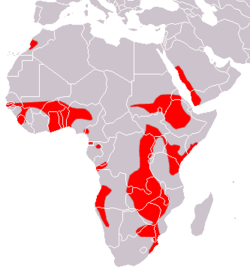 | Size: 4–6 cm (2 in) long, plus 2–4 cm (1–2 in) tail
4–6 cm (2 in) forearm length [19]
Habitat: Forest, savanna, shrubland, inland wetlands, and caves [85] | LC
Unknown  [85] [85]
|
|---|
| Telefomin roundleaf bat
| H. corynophyllus
Hill, 1985 | New Guinea
 | Size: 5–7 cm (2–3 in) long, plus 0.5–2 cm (0.2–0.8 in) tail
4–6 cm (2 in) forearm length [5]
Habitat: Forest and caves [86] | LC
Unknown  [86] [86]
|
|---|
| Thailand roundleaf bat
| H. halophyllus
Hill & Yenbutra, 1984 | Thailand
 | Size: Unknown length
3–4 cm (1–2 in) forearm length [19]
Habitat: Forest and caves [87] | VU
2,500–10,000  [87] [87]
|
|---|
| Timor roundleaf bat 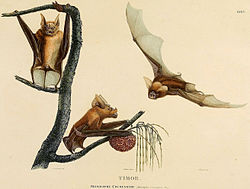 | H. crumeniferus
Lesueur & Petit, 1807 | Indonesia
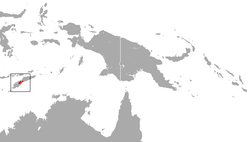 | Size: Unknown [19]
Habitat: Forest [88] | DD
Unknown  [88] [88]
|
|---|
| Wollaston's roundleaf bat
| H. wollastoni
Thomas, 1913
- H. w. fasensis
- H. w. parnabyi
- H. w. wollastoni
| New Guinea
 | Size: 4–5 cm (2 in) long, plus about 3 cm (1 in) tail
About 4 cm (2 in) forearm length [5]
Habitat: Forest and caves [89] | LC
Unknown  [89] [89]
|
|---|
















































































































